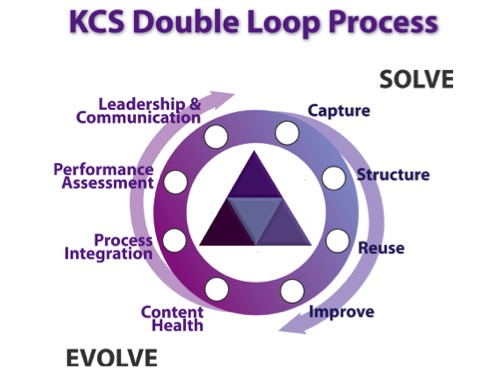The Solve Loop
In the Create Value Principle, we say "Work tasks; think big picture." The "work tasks" is the Solve Loop and the "big picture" is the Evolve Loop. We want to focus on completing tasks in the Solve Loop with an understanding of the potential benefits the collection of tasks provides in the Evolve Loop. The Evolve Loop reflects on and learns from a collection of Solve Loop tasks and associated knowledge articles. It is the organizational-level processes which analyze the patterns that emerge for a collection of tasks and knowledge use. It only works if each task is done correctly. The Solve Loop and Evolve Loop are interdependent: each enables the other.
The Solve Loop is the request-response workflow. Responders capture their resolution experiences to create a collective memory. A little bit of structure in the request-response process helps enormously, while too much structure is disruptive. Use of the knowledge base and a structured workflow increases responders speed and accuracy in solving a request. Access to the collective experience through the knowledge base also reduces re-work, i.e. not spending time solving requests that have already been solved.

Knowledge (articles) and the knowledge base are the output of the double loop KCS process.
The Solve Loop and Evolve Loop together create a system that is self-correcting. The loops are co-dependant. The Evolve Loop depends on the people doing the right thing in the Solve Loop. It is the aggregate of lots of events, each handled correctly that enables the Evolve Loop analysis. By analyzing the collection of events and related knowledge articles over time the Evolve Loop identifies areas for improvement in the Solve Loop. And, perhaps most importantly the Evolve Loop identifies opportunities for improvement to the business. The root cause analysis done in the Evolve Loop can drive improvements to products, services, processes, and policies that are based on the collective experiences of the knowledge worker and of those we serve.
Knowledge
There are four KCS Practices that contribute to the creation and maintenance of knowledge in the Solve Loop:
-
Capture - capture in the workflow: while responding to the request, we capture the requestor's context (their words and phrases) as well as the responder's knowledge. As tacit knowledge becomes explicit in the context of use, it becomes part of the article. (Tacit knowledge is stuff we know but don't know we know, until someone asks.) Capturing this tacit information makes the article findable and reuseable.
-
Structure - structure for reuse: consistent structure, simple templates, and a crisp style improves KCS article readability. We can identify existing KCS articles and their relevant elements quickly to reduce the solving cycle and ensure that new KCS articles build on and integrate with existing knowledge.
-
Reuse - the words and phrases entered to search should be preserved. They are valuable content that can be used and reused to improve existing KCS articles. Or, in the event a KCS article does not exist, the phrases used to search become the beginning of a new KCS article. Searching the knowledge base is part of the request-response process. "Search early, search often" ensures that we are not solving a request that has already been solved and that we benefit from the collective experience of the network. Searching early and often also reduces duplicate knowledge articles.
-
Improve - reuse is review: as responders, we take responsibility for the articles we interact with. The knowledge base is our collective experience. If we see something that is wrong or that we do not understand, we have the responsibility to "flag it or fix it." If we are confident in the correction and we are authorized with a KCS license, we should fix it. If we are not confident or licensed, we should flag it. If this sense of ownership is developed, reuse becomes review. We constantly review and improve the KCS articles that are being used. Allowing licensed users to edit articles reduces duplicates, keeps articles up to date, and assures high quality and value.
A Shift in Values
For most organizations, the Solve Loop practices are not natural. Our traditional performance measurement practices have not promoted collaborative behaviors—the assessment of contribution has been focused on the individual. In many cases, individual assessment promotes competition, not collaboration. Stack ranking of employees, for example, encourages a competitive attitude that does not promote sharing, improving, or reusing the collective experience captured in the knowledge base.
Many organizations create a hero mentality when they reward the "dragon slayers" or those who time the "diving catch" just right. These organizations communicate a clear value proposition: you are valued for what you know. If the organization values people for what they know, there is no hope for KCS success. KCS success requires the organization to shift the value proposition to the individual to: you are valued for your ability to learn, and your ability to help others learn. If this becomes the value proposition, then we are encouraging the behaviors of collaboration, sharing, and improving. This value shift requires a new performance assessment model outlined in the Performance Assessment section.
The good news: most people do collaborate. Fortunately, they do the right thing in spite of the traditional organizational structures, measures, and linear processes. With KCS, we can begin to evaluate the value of collaboration through the sharing of knowledge. The knowledge base becomes a collaboration space.
Putting KCS to Work
In the next sections we will walk through the eight practices of the Solve and Evolve Loops in detail.
